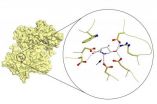(Press-News.org) In eukaryotes – the group of organisms that include humans – a key to survival is the ability of certain proteins to quickly and accurately repair genetic errors that occur when DNA is replicated to make new cells.
In a paper published in the December 23, 2011 issue of the journal Science, researchers at the Ludwig Institute for Cancer Research and the University of California, San Diego School of Medicine have solved part of the mystery of how these proteins do their job, a process called DNA mismatch repair (MMR).
"One of the major questions in MMR is how MMR proteins figure out which base in a DNA mispair is the wrong one," said Ludwig Institute assistant investigator Christopher D. Putnam, PhD, an adjunct assistant professor of medicine at UC San Diego. "For example, if guanine (G) is inappropriately in a base-pair with thymine (T), is the G or the T the error? Picking the wrong base results in mutations, not fixes."
Using Saccharomyces cerevisiae, or baker's yeast, as their model organism, the researchers, led by Richard D. Kolodner, PhD, Ludwig Institute investigator and UCSD professor of medicine and cellular and molecular medicine, discovered that newly replicated DNA produces a temporary signal for 10 to 15 minutes after replication which helps identify it as new – and thus a potential subject for MMR.
The actual signal was not identified, but Putnam said it might be tell-tale nicks in single-stranded DNA or certain proteins associated with replication. The scientists are working to pinpoint the precise signal.
The findings, combined with earlier, published work that visualized MMR in a living cell for the first time, more fully explains how eukaryotes eliminate DNA replication errors, which can result in defects and the development of cancers.
"How eukaryotes identify the newly synthesized strand of DNA is a mystery that has persisted for at least 30 years," said Putnam. "These findings really change our ideas of how MMR works," said Putnam.
###Co-authors include Hans Hombauer and Anjana Srivatsan of the Ludwig Institute for Cancer Research, UCSD Departments of Medicine and Cellular and Molecular Medicine, Institute of Genomic Medicine and UC San Diego Moores Cancer Center.
Funding for this research came from the National Institutes of Health.
DNA mismatch repair happens only during a brief window of opportunity
2011-12-23
ELSE PRESS RELEASES FROM THIS DATE:
Biochemists develop promising new treatment direction for rare metabolic diseases
2011-12-23
AMHERST, Mass. – A research team led by biochemist Scott Garman at the University of Massachusetts Amherst has discovered a key interaction at the heart of a promising new treatment for a rare childhood metabolic disorder known as Fabry disease. The discovery will help understanding of other protein-folding disorders such as Alzheimer's, Parkinson's and Huntington's diseases, as well. Findings are featured as the cover story in the current issue of Chemistry & Biology.
People born with Fabry disease have a faulty copy of a single gene that codes for the alpha-galactosidase ...
UT-ORNL research reveals aquatic bacteria more recent move to land
2011-12-23
Research by University of Tennessee, Knoxville, faculty has discovered that bacteria's move from sea to land may have occurred much later than thought. It also has revealed that the bacteria may be especially useful in bioenergy research.
Igor Jouline, UT-Oak Ridge National Laboratory joint faculty professor of microbiology and researcher at ORNL's Joint Institute for Computational Sciences, performed a genome sequence analysis of the soil bacteria Azospirillum, a species' whose forbearers made the sea-to-land move. The analysis indicates the shift may have occurred ...
Long intervening non-coding RNAs play pivotal roles in brain development
2011-12-23
FINDINGS: Whitehead Institute scientists have identified conserved, long intervening non-coding RNAs (lincRNAs) that play key roles during brain development in zebrafish, and went on to show that the human versions of these RNAs can substitute for the zebrafish lincRNAs.
RELEVANCE: Despite their prevalence in the cell, lincRNAs have been referred to as the "dark matter" of all the transcribed RNAs because little is known of their functions or mechanisms. Until now, lincRNAs have been studied primarily in cell lines rather than at the organismal level, which has precluded ...
Unnatural disasters
2011-12-23
Global wildlife is facing an unprecedented threat from natural disasters exacerbated by climate change, warn scientists in a paper published in Trends in Ecology and Evolution.
Hurricanes, droughts, flooding and wildfires are predicted to increase in frequency and severity – but despite being able to spot human populations at risk, there is currently no mechanism for identifying vulnerable animal populations.
Now scientists from the Zoological Society of London (ZSL) have come up with a method to identify populations likely to experience drastic changes in their population ...
NIH researchers uncover clues related to metal-on-metal hip implants
2011-12-23
A new study, bringing together an interdisciplinary team of physicians and engineers from the United States and Germany, made a surprising finding about implants used in hip replacement surgery: Graphite carbon is a key element in the lubricating layer that forms on metal-on-metal hip implants. The lubricant has more in common with the lubrication of a combustion engine than that of a natural joint. The study was funded by the National Institute of Arthritis and Musculoskeletal and Skin Diseases (NIAMS), part of the National Institutes of Health.
Made possible by an ...
Carlsbad Mayor, CDOD: Positive News About WIPP 2012 Budget
2011-12-23
Members of New Mexico's congressional delegation have shown their strong support of the Waste Isolation Pilot Plant's safety record and operational success by fighting to keep the Department of Energy facility sufficiently funded.
The Waste Isolation Pilot Plant, or WIPP, is the Department of Energy's underground repository for defense-generated, transuranic (TRU) waste. Since WIPP opened in 1999, more than 10,000 shipments of TRU waste have been permanently disposed of in salt beds 2,150 feet below the surface. WIPP is located about 26 miles outside of Carlsbad, New ...
'Nanoantennas' show promise in optical innovations
2011-12-23
WEST LAFAYETTE, Ind. – Researchers have shown how arrays of tiny "plasmonic nanoantennas" are able to precisely manipulate light in new ways that could make possible a range of optical innovations such as more powerful microscopes, telecommunications and computers.
The researchers at Purdue University used the nanoantennas to abruptly change a property of light called its phase. Light is transmitted as waves analogous to waves of water, which have high and low points. The phase defines these high and low points of light.
"By abruptly changing the phase we ...
New Dabota Chairs and Skidmore Chairs From Rattanland
2011-12-23
RattanLand, a Company specializing in the import and export of home furniture, has new products to offer to its customers worldwide - Dabota Chairs and Skidmore Chairs.
New Skidmore and Dabota Chairs
The Company is proud to announce two new products that have been added to its already impressive product range - Skid and Dabota chairs.
Skidmore chairs are classic looking chairs that come with a simple design. There are no armrests, and the chairs sit on four legs each. These chairs are ideal for the outdoor garden or porch.
Dabota chairs also come in a simple ...
Blood progenitor cells receive signals from niche cells and the daughter blood cells they create
2011-12-23
Maintaining balance is crucial. In Drosophila, the common fruit fly, the creation and maintenance of the blood supply requires such balance.
UCLA stem cell scientists have now uncovered that two-way signaling from two different sets of cells is necessary for that balance, both to ensure enough blood cells are made to respond to injury and infection and that the blood progenitor cell population remains available for future needs.
The stem cell-like blood progenitor cells – which contribute to the cells of the adult fruit fly's blood supply – receive signals from cells ...
Defending the genome
2011-12-23
WORCESTER, Mass. – Small, mobile sequences of DNA left over from viruses, called transposons or "jumping genes" because of their ability to move around the genome, pose a significant threat to the genetic integrity and stability of an organism. Considered genetic parasites, these transposable elements are believed to comprise as much as 50 percent of the human genome. Because of the damage transposons can do to an organism's DNA, an immune-like response has evolved to turn off, or silence, these mobile genetic elements.
New research published in the journal Cell by the ...

